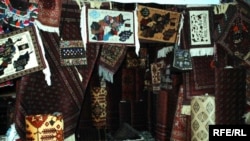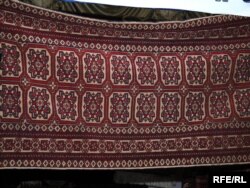* Correction appended
Emerging after decades of conflict, Afghanistan's carpet-weaving industry is seeking to reestablish itself and its centuries of tradition on the international market.
In the northern city of Mazar-e Sharif, the Union of Afghan Carpet Producers and Exporters held an exhibition to celebrate the Norouz holiday, which marks the spring equinox. Its title and intention were "How to Find International Markets for Afghan Carpets."
The exhibition included a display organized by the Afghan Women Traders' Union in Mazar-e Sharif, whose chairwoman, Noria Azizi, explains that she and her union did not know how to access international markets. She knew that Afghan carpets were famous in the United States, but contacts had been broken and lost, and the export trade severely damaged.
And where, one must wonder, does the all-important raw material, wool, come from to supply this war-torn country?
"If the Afghan government wants to develop the carpet industry in Afghanistan, they must stop illegal carpet exporting, and help to provide good-quality material for carpet production," says Syad Taher Roshanzadh, chairman of the Chamber of Trade in Mazar-e Sharif, one of the sponsors of the recent carpet exhibition.
"The government should also encourage Afghan carpet producers and provide opportunities for promotion," he adds.
Looking To The Past
For carpet weaving, the quality of wool is all-important; it must be hard-wearing, strong, and resilient. Roshanzadh's plea is surely a heart-breaking sign of the times, for carpets -- before the disruptions of the Taliban and subsequent and ongoing strife -- of its own manufacture and those of neighboring Central Asian tribes, were among Afghanistan's most important trade and export goods.
Caravans transported goods, including rugs, from Central Asia, and the routes passed through Afghanistan, into the Indian subcontinent, and to the trading posts on the Indian Ocean. These ancient routes through inhospitable terrain, dipping down into and through modern-day Pakistan, are still used by traders and smugglers.
Both in Afghanistan and in Pakistan, in the camps set up for Afghan refugees from the Russian, Taliban, and subsequent troubles, Afghan weavers continued to weave their histories into rugs, producing designs that combine traditional colors and motifs with helicopters, Kalashnikovs, tanks, and other military motifs. Such rugs are avidly collected by foreigners stationed in or passing through Afghanistan, and in recent years there have been several exhibitions of them.
For most Western nonspecialists, "Afghan" and "Turkoman" denote a wide range of rugs with repeating geometric patterns laid out in a grid, whose dominant color is a rich dark red, with dark brown, black, camel, and touches of dark and light indigo that can veer toward sea green. Occasionally a rug has tiny highlights of bright silk, a touch of mauve or amber, pinkish-ruby, or pistachio.
Their intense colors glowed inside nomadic yurts, and when exported to the West, they enhanced traditional and antique furnishings as well as very modern homes. In the 1960s there was a great fashion for "Golden Afghans," which were traditional carpets imported and then treated in the West with a chemical wash that bleached the red dye, leaving an amber carpet that still displayed its traditional pattern.
These rugs were traditionally woven by nomadic tribes, or semi-nomads living near towns that were trading centers, although towards the latter part of the 20th century demand for this type of carpet was so strong that ateliers, or factories, were established, within which the weavers worked on permanent looms, rather than the portable frames used by nomads.
Traditional Craftwork
Even if factory-produced, the rugs were still hand-knotted, and hand-woven. Knots per inch is not an important factor in tribal rugs, their textures vary, from a soft, floppy rug that can be folded, to one with tight knots and stiff texture that can only be folded. It depends which function the rug was made to serve.
Rugs woven for export tend to have a firm weave in order to survive the traffic of shod feet. Modern silk rugs are judged by knots per square inch or centimeter, but silk rugs are not an Afghan specialty, although in Pakistan and Kashmir Afghan and Turkoman patterns are copied in silk or a combination of silk and wool. These are then marketed as "Royal Bokhara" or some similarly optimistic term.
Carpet weaving requires an ample supply of raw material, and the nomads used goat hair and wool from their own hardy flocks. Over thousands of years, they developed their own intricate patterns, which are a form of heraldry and tribal history, denoting the tribes and their affiliations, occasional intertribal marriages, even the annihilation of one tribe by another, or the political forces which rose, ruled and fell.
Many patterns evolved in the pre-Islamic era, and hark back to shamanistic origins. Some have designs from Chinese or Mongol sources (cloud bands, dragons, lotus palmettes) and tribal jewelry, flowers, animals, birds, and stick person appear as minor motifs -- coffee pots and water ewers, pomegranates, signifying fertility, trees, the ancient symbol for life and regeneration, and others whose original intention is long lost.
Some rugs even mimic silk ikats. But the overall pattern is always geometric, natural to the square grid created by intersecting warp and weft of weaving, and within a strict color palette. Pile carpets are knotted onto warp threads, secured by the horizontal wefts, which are firmly banged down on each pass, and the resulting looped surface is sheared to give the typical fur-mimicking surface.
As with the patterns, the colors are distinctive to their tribal origins. The size, shape, and pattern also indicate the rug's original purpose; prayer rugs, with their directional design, are easy to identify, as are the cruciform-patterned rugs intended to cover an entrance. The subject is a mine field of complexities, and a field of endless fascination -- fascination leading easily into obsession.
Philippa Scott is the author of "The Book of Silk" and "Turkish Delights," both published by Thames and Hudson.
* A description of the Norouz holiday in the second paragraph was reworded for clarification.
Emerging after decades of conflict, Afghanistan's carpet-weaving industry is seeking to reestablish itself and its centuries of tradition on the international market.
In the northern city of Mazar-e Sharif, the Union of Afghan Carpet Producers and Exporters held an exhibition to celebrate the Norouz holiday, which marks the spring equinox. Its title and intention were "How to Find International Markets for Afghan Carpets."
The exhibition included a display organized by the Afghan Women Traders' Union in Mazar-e Sharif, whose chairwoman, Noria Azizi, explains that she and her union did not know how to access international markets. She knew that Afghan carpets were famous in the United States, but contacts had been broken and lost, and the export trade severely damaged.
And where, one must wonder, does the all-important raw material, wool, come from to supply this war-torn country?
"If the Afghan government wants to develop the carpet industry in Afghanistan, they must stop illegal carpet exporting, and help to provide good-quality material for carpet production," says Syad Taher Roshanzadh, chairman of the Chamber of Trade in Mazar-e Sharif, one of the sponsors of the recent carpet exhibition.
"The government should also encourage Afghan carpet producers and provide opportunities for promotion," he adds.
Looking To The Past
For carpet weaving, the quality of wool is all-important; it must be hard-wearing, strong, and resilient. Roshanzadh's plea is surely a heart-breaking sign of the times, for carpets -- before the disruptions of the Taliban and subsequent and ongoing strife -- of its own manufacture and those of neighboring Central Asian tribes, were among Afghanistan's most important trade and export goods.
Caravans transported goods, including rugs, from Central Asia, and the routes passed through Afghanistan, into the Indian subcontinent, and to the trading posts on the Indian Ocean. These ancient routes through inhospitable terrain, dipping down into and through modern-day Pakistan, are still used by traders and smugglers.
Both in Afghanistan and in Pakistan, in the camps set up for Afghan refugees from the Russian, Taliban, and subsequent troubles, Afghan weavers continued to weave their histories into rugs, producing designs that combine traditional colors and motifs with helicopters, Kalashnikovs, tanks, and other military motifs. Such rugs are avidly collected by foreigners stationed in or passing through Afghanistan, and in recent years there have been several exhibitions of them.
For most Western nonspecialists, "Afghan" and "Turkoman" denote a wide range of rugs with repeating geometric patterns laid out in a grid, whose dominant color is a rich dark red, with dark brown, black, camel, and touches of dark and light indigo that can veer toward sea green. Occasionally a rug has tiny highlights of bright silk, a touch of mauve or amber, pinkish-ruby, or pistachio.
Their intense colors glowed inside nomadic yurts, and when exported to the West, they enhanced traditional and antique furnishings as well as very modern homes. In the 1960s there was a great fashion for "Golden Afghans," which were traditional carpets imported and then treated in the West with a chemical wash that bleached the red dye, leaving an amber carpet that still displayed its traditional pattern.
These rugs were traditionally woven by nomadic tribes, or semi-nomads living near towns that were trading centers, although towards the latter part of the 20th century demand for this type of carpet was so strong that ateliers, or factories, were established, within which the weavers worked on permanent looms, rather than the portable frames used by nomads.
Traditional Craftwork
Even if factory-produced, the rugs were still hand-knotted, and hand-woven. Knots per inch is not an important factor in tribal rugs, their textures vary, from a soft, floppy rug that can be folded, to one with tight knots and stiff texture that can only be folded. It depends which function the rug was made to serve.
Rugs woven for export tend to have a firm weave in order to survive the traffic of shod feet. Modern silk rugs are judged by knots per square inch or centimeter, but silk rugs are not an Afghan specialty, although in Pakistan and Kashmir Afghan and Turkoman patterns are copied in silk or a combination of silk and wool. These are then marketed as "Royal Bokhara" or some similarly optimistic term.
Carpet weaving requires an ample supply of raw material, and the nomads used goat hair and wool from their own hardy flocks. Over thousands of years, they developed their own intricate patterns, which are a form of heraldry and tribal history, denoting the tribes and their affiliations, occasional intertribal marriages, even the annihilation of one tribe by another, or the political forces which rose, ruled and fell.
Many patterns evolved in the pre-Islamic era, and hark back to shamanistic origins. Some have designs from Chinese or Mongol sources (cloud bands, dragons, lotus palmettes) and tribal jewelry, flowers, animals, birds, and stick person appear as minor motifs -- coffee pots and water ewers, pomegranates, signifying fertility, trees, the ancient symbol for life and regeneration, and others whose original intention is long lost.
Some rugs even mimic silk ikats. But the overall pattern is always geometric, natural to the square grid created by intersecting warp and weft of weaving, and within a strict color palette. Pile carpets are knotted onto warp threads, secured by the horizontal wefts, which are firmly banged down on each pass, and the resulting looped surface is sheared to give the typical fur-mimicking surface.
As with the patterns, the colors are distinctive to their tribal origins. The size, shape, and pattern also indicate the rug's original purpose; prayer rugs, with their directional design, are easy to identify, as are the cruciform-patterned rugs intended to cover an entrance. The subject is a mine field of complexities, and a field of endless fascination -- fascination leading easily into obsession.
Philippa Scott is the author of "The Book of Silk" and "Turkish Delights," both published by Thames and Hudson.
* A description of the Norouz holiday in the second paragraph was reworded for clarification.

















